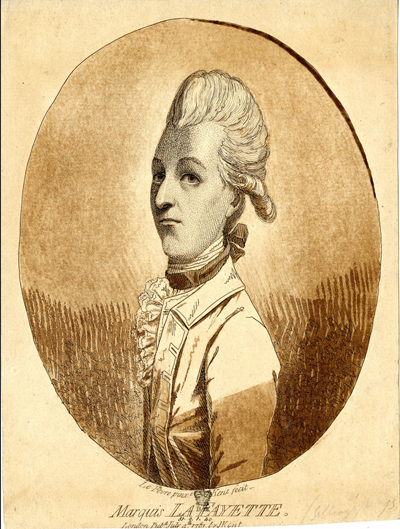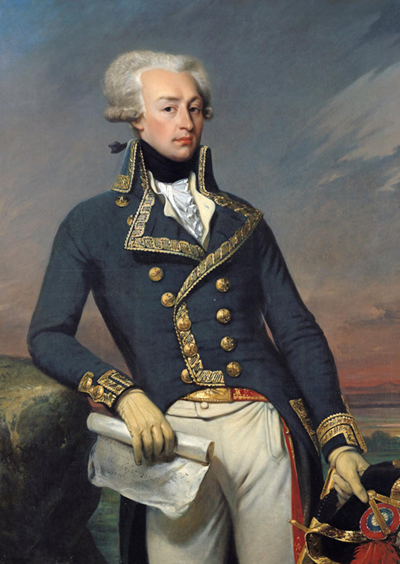Marquis La Fayette
This is one of two portraits by Gillray of well-known opponents of British interests: the Marquis La Fayette, the French General who provided so much military support for the American revolution that the Americans named a warship after him, and Pensionary Van Berkel, the Dutch instigator of a secret treaty with the Americans and a major critic of the policies of William V, Prince of Orange. Both show Gillray experimenting with rollers, stippling, and aquatint—techniques more often used in "serious" portraiture than caricature. Both are listed as being published on the same day, July 4th, 1781, 5 years to the day that America declared her independence. And both list the publisher as "J. Kent," a pseudonym Gillray used frequently in the 1780's, but usually as the engraver ("J. Kent fecit") rather than publisher.

© Trustees of the British Museum
If we assume that the British Museum is correct in attributing the production of the print Hyder Ally (June 13, 1781) to Gillray, the La Fayette and Van Berkel prints seem to have been part of a concerted effort by Gillray in 1780/81 to earn a living from sources other than caricature/satire. This would have included portraits of people in the news (like this one), illustrations of literary works like Tom Jones in August and September 1780, and the production of sentimental furniture prints (five in November 1781).
Gillray's involvement in the portrait of Hyder Ali for the publisher Robert Wilkinson seems to have been confined to the tracing and etching of an earlier French print. But it may have suggested the portraits of La Fayette and Van Berkel as potential experiments and moneymakers. And the fact that the publisher is NOT Wilkinson may indicate that Gillray was experimenting with more than just technique and subject matter. He may have felt that he could increase his share of the profits from his efforts if he was his own publisher.
The portrait of LaFayette is supposed to be based on a painting by LeFevre ("LeFevre pinxit"), but the only contemporary French painter I've been able to find by that name is Robert LeFevre, whose work does not seem to have appeared any earlier than the 1790s. It somewhat resembles a later painting of La Fayette by Joseph-Désiré Court, but Court's painting was not completed until 1833. It's possible that both portraits were created based on a common (and still undiscovered) source.

Marquis La Fayette [December 31, 1833]
But since Gillray is himself working under an alias in this print, it's not unlikely that LeFevre as designer is also a fiction. And instead, Gillray may simply be alluding to another French soldier and Lieutenant, Le Fevre in Laurence Sterne's Tristram Shandy, who, like La Fayette, was wounded in battle, and whose story captured the public imagination.
Sources and Reading
- Commentary from the British Museum on Marquis La Fayette
- "Gilbert du Motier, Marquis de Lafayette," Wikipedia
- "The Garden of Romance/The Story of Le Fevre," Wikisource
- Robert LeFevre, Napoleon.org
Comments & Corrections
NOTE: Comments and/or corrections are always appreciated. To make that easier, I have included a form below that you can use. I promise never to share any of the info provided without your express permission.